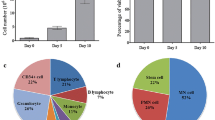Abstract
Peripheral blood lymphocytes from healthy, Epstein-Barr virus (EB-virus)-seropositive donors and from patients with acutePlasmodium falciparum malaria were tested for their cytotoxicity towards autologous EB-virus-infected B-cells using an in vitro regression assay. Of the 18 cultures from control donors, 88.8% showed the normal pattern of regression. Of the 20 malaria patients in the study, 40% failed to exhibit the normal pattern observed in the control group. Analysis of the lymphocyte subsets showed a high incidence of inverted CD4∶CD8 ratios in the patient group due to an absolute rise in the CD8 population. This data suggests that the immunosuppressive effects of acute malaria extend to defective control over EB-virus. The relevance of the observations to the aetiology of EB-virusassociated, endemic Burkitt's lymphoma (eBL) is discussed.
Similar content being viewed by others
References
Armitage P (1974) Statistical methods in medical research, 3rd edn. Blackwell Scientific, London
Burkitt D, Wright DH (1970) Burkitt's lymphoma. Livingstone, Edinburgh
Crawford DH, Edwards JMB, Sweny P, Hoffebrand AV, Jannosy G (1981) Studies on long term T-cell mediated immunity to Epstein-Barr virus in immunosuppressed renal allograft recipients. Int J Cancer 28:705–710
Edington GM, Maclean CMU, Ukubadejo OA (1963) Incidence of Burkitt's lymphoma in areas of highPlasmodium falciparum transmission. Proceedings, Symposium on Lymphoid Tumours in Africa, Paris. WHO, Geneva, p 236
Epstein MA (1984) Burkitt's lymphoma: clues to the role of malaria. Nature 312:398
Facer CA, Playfair JHL (1989) Malaria, Epstein-Barr virus and the genesis of lymphomas. Adv Cancer Res 53:33–72
Facer CA, Kataaha PK, Holborow EJ (1985) Spontaneous transformation in vitro of lymphocytes from patients with acutePlasmodium falciparum malaria: a preliminary report. Trans R Soc Trop Med Hyg 79:275–276
Facer CA, Bentley A, Whithers M, Kataaha PK (1986) Malaria and ELISA HTLV-III reactivity. Trans R Soc Trop Med Hyg 80:351–352
Gaston JS, Rickinson AB, Epstein MA (1982) EB-virus specific memory T-cells in renal allograft recipients under long-term immunosuppression. Lancet 24:923–924
Geser A, Brubaker G (1985) A preliminary report of the epidemiological studies of Burkitt's lymphoma, Epstein-Barr virus infection and malaria in North Mara, Tanzania. In: Lenoir G, O'Connor G, Olwerey CLM (eds). Burkitt's lymphoma—a human cancer model, IARC Scientific, Lyon, pp 205–223
Henle W (1985) EBV and human malignancies. Adv Viral Oncol 5:580–612
Henle W, Henle G (1985) Epstein-Barr virus and human malignancies. Adv Viral Oncol 5:201–222
Kataaha PK, Facer CA, Holborow EJ (1984)Plasmodium falciparum products enhance human lymphocyte transformation by Epstein-Barr virus. Clin Exp Immunol 56:371–376
Keoh YK, Yeoh KL (1982) Haematological alterations in acute malaria. Scand J Haematol 29:147–159
Klein G, Klein E (1986) Conditioned tumorigenicity of activated oncogenes. Cancer Res 46:3211–3228
Marsh K, Greenwood BM (1986) Immunopathology of malaria. Clin Trop Med Commun Dis 1:91–96
Morrow RH (1985) Epidemiological evidence for the role of falciparum malaria in the pathogenesis of Burkitt's lymphoma In: Lenoir G, O'Connor G, Olwerey CLM (eds) Burkitt's lymphoma—a human cancer model. IARC Scientific, Lyon, No. 60, pp 177–185
Moss DJ, Burrow SR, Castilino DJ, Kona RG, Pope JH, Rickinson AB, Alpers MP, Heywood PF (1983) A comparison of Epstein-Barr virus-specific T-cell immunity in malaria endemic and nonendemic regions of Papua New Guinea. Int J Cancer 31:727–739
Ragona G, Sirianni MC, Soddu S, Vercelli B, Sebastiani G, Plecon M, Aiuh F (1986) Evidence for dysregulation in the control of Epstein-Barr virus latency in patients with AIDS-related complex. Clin Exp Immunol 66:77–86
Rickinson AB, Crawford DH, Epstein MA (1977) Inhibition of the outgrowth of Epstein-Barr virus transformed lymphocytes by thymus-dependent lymphocytes from infectious mononucleosis patients. Clin Exp Immunol 28:72–76
Rickinson AB, Gaston JS, Epstein MA (1980) Long-term T-cell-mediated immunity to Epstein-Barr virus in man: IV. Development of T-cell memory in convalescent infectious mononucleosis patients. Int J Cancer 25:59
Sakane T, Kotani H, Takadu S, Murakawa Y, Ueda Y (1983) A defect in the suppressor circuits among OKT4+ cell populations in patients with systemic lupus erythematosus occurs independently of a defect in the OKT8+ suppressor T-cell function. J Immunol 131:753–761
Schooley RT, Haynes AJ, Grouse J, Payling-Wright C, Fauci AS, Dolini R (1981) Development of suppressor T-lymphocytes for Epstein-Barr virus-induced B-lymphocyte outgrowth during acute infections mononucleosis: assessment by two quantitative methods. Blood 57:510–514
Thorley-Lawson DA, Strominger JL (1977) Suppression of in vitro Epstein-Barr virus infection: a new role for adult human T-lymphocytes. J Exp Med 46:495–508
Troye-Blomberg M, Sjoholm PE, Perlmann H, Patarroyo ML, Perlmann P (1983) Regulation of the immune response inPlasmodium falciparum malaria: I. Non-specific proliferative response in vitro and characterization of lymphocytes. Clin Exp Immunol 53:335–341
Weidanz WP (1982) Macrophage-mediated and T-cell mediated immunosuppression in malaria. Br Med Bull 38:167–168
Whittle H, Brown J, Marsh K, Greenwood BM, Seidlin P, Tighe H, Wedderburn L (1984) T-cell control of Epstein-Barr virus-infected B-cells is lost duringPlasmodium falciparum malaria. Nature 312:449–450
Yao QY, Rickinson AB, Gaston JSH, Epstein MA (1985) In vitro analysis of the Epstein-Barr virus: host balance in long-term renal allograft recipients. J Immunol 135:959–964
Author information
Authors and Affiliations
Rights and permissions
About this article
Cite this article
Gunapala, D.E., Facer, C.A., Davidson, R. et al. In vitro analysis of Epstein-Barr virus: Host balance in patients with acutePlasmodium falciparum malaria. Parasitol Res 76, 531–535 (1990). https://doi.org/10.1007/BF00931060
Accepted:
Issue Date:
DOI: https://doi.org/10.1007/BF00931060




